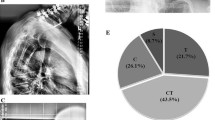Abstract
The authors report on 32 consecutive patients with instability at the craniocervical, cervical and cervicothoracic regions suffering from various pathologies, who were treated with posterior instrumentation and fusion using the posterior hooks-rods-plate cervical compact Cotrel-Dubousset (CCD) instrumentation alone or, in three patients, in combination with anterior operation. The patients were observed postoperatively for an average of 31 months (range 25–44 months) and evaluated both clinically and radiographically using the following parameters: spine anatomy and reconstruction, sagittal profile, neurologic status, functional level, complications and status of arthrodesis. All patients but one (who died) achieved a solid arthrodesis based on plain and flexion/extension roentgenograms. Cervical lordosis (skull–C7) and cervicothoracic kyphosis (C7–T2) was improved by instrumentation towards a physiological lateral curve by an average of 33% (P<0.05) and 28% (P<0.05) respectively. Anterior vertebral olisthesis was reduced in the craniocervical and cervicothoracic region, by 73% and 90% respectively. At final follow-up there was an improvement of the neurologic Frankel status by an average of 1.2 grades and of myelopathy in 75% of the operated patients. Good to excellent functional results were seen in 77% of the operated patients, while acute and chronic pain was reduced by an average of 2.4 grades, on a scale of 0–3, in operated patients. No neurovascular or pulmonary complications arose from surgery. There was no significant change in lateral spine profile and olisthesis at the latest follow-up evaluation. There were no instrument-related failures. One patient requested hardware removal in the hope of reducing postoperative pain in the cervicothoracic region. The poor and fair results were related to the lack of improvement of neurologic impairment and myelopathy. The results of this study demonstrate that cervical CCD instrumentation applied in the region of the skull to the upper thoracic region for various disorders is a simple and safe instrumentation that restores lateral spine alignment, improves the potential for a solid fusion and offers sufficient functional results in the vast majority of the operated patients. However, the use of hooks in spinal stenosis is contraindicated.
Similar content being viewed by others
Author information
Authors and Affiliations
Additional information
Electronic Publication
Rights and permissions
About this article
Cite this article
Korovessis, P., Katonis, P., Aligizakis, A. et al. Posterior compact Cotrel-Dubousset instrumentation for occipitocervical, cervical and cervicothoracic fusion. Eur Spine J 10, 385–394 (2001). https://doi.org/10.1007/s005860100245
Received:
Revised:
Accepted:
Published:
Issue Date:
DOI: https://doi.org/10.1007/s005860100245




